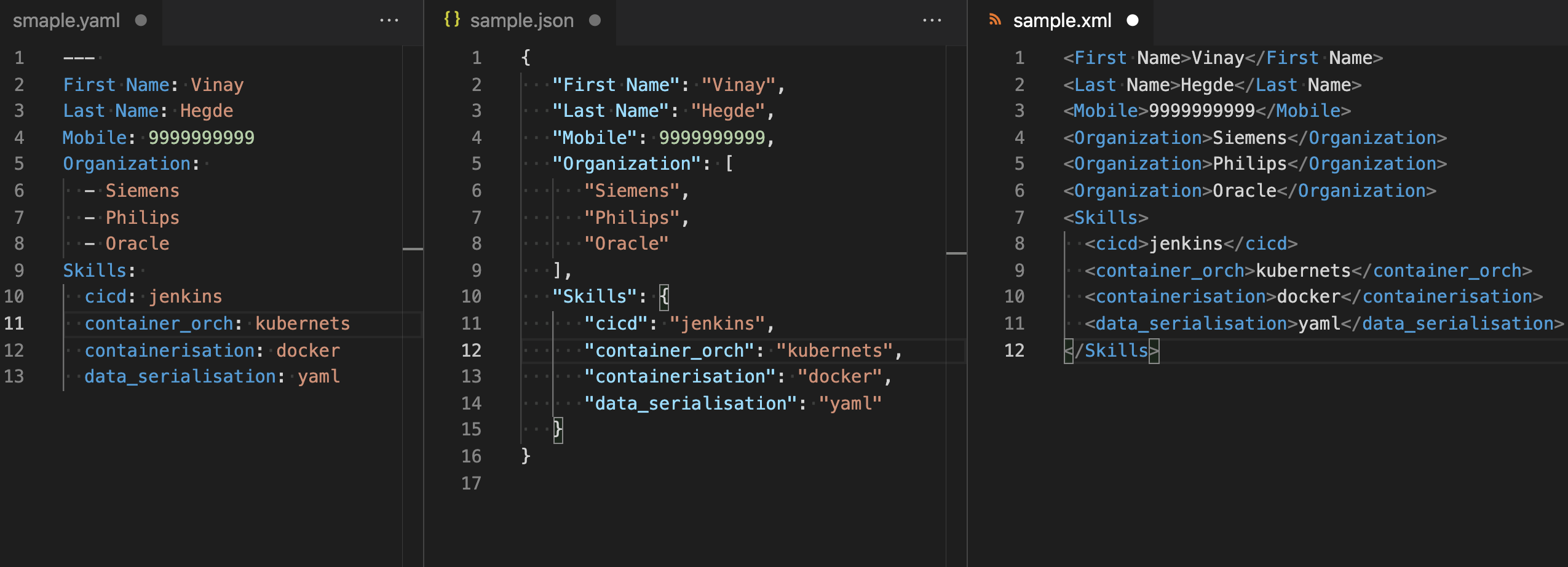YAML
Overview
YAML is a serialization language
What is serialization language?
Application written in different technology/different languages etc which have different data structure can transfer data between each other using common agreed on or standard format. Most popular such formats are YAML, JSON & XML
YAML - YAML Ain’t Markup Language
YAML poplularity has increased in the past few years because, it is super human readable & intuitive. This makes YAML a great fit for writing configuration files for all those recent deveops tools like docker, kubernetes etc.
File extension: .yaml or .yml
Let’s consider a data structure and see how it is written in YAML, JSON & XML

As you see above, XML & JSON datastrucure are defined using special characters. Where as in YAML, there is no special characters.
XML - texts with angular brackets
JSON - texts with curly brackets
JSON - Data structure are handled through line separation & indentation
In YAML, you will get validation error if indentation is wrong, which may be little bit annoying but it makes yaml format the cleanest most human readable format of all three.
YAML is used in Docker compose file, Ansible, Prometheus, Kubernetes and many more tools.
YAML Syntax
Data types
There are 3 data types:
- Scalar
- List
- Object or Dictionary
- Scalar
In YAML, scalar means a simple value for a key. The value of the scalar can be integer, float, Boolean and string.
<key>: <value>
Scalar data types are classified into two data types: 1. Numeric data type 2. String
Numeric Data type - Here, values can be Integer or float or boolean. Values are NOT enclosed in quotes.
Boolean values can be: yes/no, true/false, on/off
For example:
age: 65
rating: 4.5
light: on
started: yes
enabled: true
String - Unicode strings optionally enclosed by quotes (i.e. Quotes are optional. if you have any specal character like \n, then you need to enclose it in double quotes).
- List
Elements in a list are created using -
For example:
List with just values:
colurs:
- red
- yellow
- blue
price:
- sixty
- seventy
- 50
List with attributes (key: values):
languages:
- python: backend
- javascript: frontend
Note: items in the list can be written without indentation also.
We can define the list in a single line as well. For example:
price: [sixty, 50, “seventy”]
- Object OR Dictinory
We can group the key value files in an object. syntax is,
<object_name>:
<Key>: <value>
<Key>: <value>
For example:
Skills:
cicd: jenkins
container_orch: kubernets
containerisation: docker
data_serialisation: yaml
Please note, space has to be exactly same for each attribute. YAML doesn’t support TABs.
YAML is senstive about spaces & indentation. We can use online Yaml validator to validate the syntax.
Comments
Comments in YAML starts with #
For example:
# This is a comment
Multiline String
Multiline strings are written using |
For example:
profile: |
I am a devops engineer.
I work for XYZ company.
Single line string written in multiline using >
For example:
profile: >
I am a devops engineer,
working for XYZ company.
It will be displayed as, I am a devops engineer, working for XYZ company.
Environemnt variables
YAML doesn’t natively support environemnt variables (to use/access). But the parser should have a logic to interpolate the environment variables.
Typically syntax would be, $variable_name or ${variable_name}
For example, pyyaml/yaml library in Python doesn’t resolve environment variables by default. You need to define an implicit resolver that will find the regex that defines an environment variable and execute a function to resolve it.
Placeholder
- YAML does not natively support variable placeholders.
- Anchors and Aliases almost provide the desired functionality, but these do not work as variable placeholders that can be inserted into arbitrary regions throughout the YAML text. They must be placed as separate YAML nodes.
- There are some add-on libraries that support arbitrary variable placeholders, but they are not part of the native YAML specification.
Refer this stackoverflow link for more details: stackoverflow
Typically syntax would be,
{{ variable_name }}
Multiple YAML components in a single file
Multiple components in a single YAML file is written using 3 dashes —–
Kubernetes POD configuration file (in YAML) explained
apiVersion: v1
kind: Pod
metadata:
name: nginx
labels:
app: nginx
spec:
containers:
- name: nginx-container
image: nginx
ports:
- containerPort: 80
VolumeMounts:
- name: nginx-VolumeMounts
mountPath: /usr/nginx/html
- name: sidecar-container
image: curlimages/curlimages
command: ["/bin/sh"]
args: ["-c", "echo Hello from the sidecar container; sleep 300"]
Here,
apiVersion: v1 is a key-value pair (scalar data)
kind: Pod is a key-value pair
metadata is an object with 2 items.
-
name: nginxakey-valuepair -
labels:another object with akey valuepairapp: nginx
spec: is an object with one item.
contaners:alistof objects
containers list contains 2 items.
-
An
objectcontaining ‘nginx-container’ details -
An
objectcontaining ‘sidecar-container’ details
ports: is a list inside the 1st object of ‘containers:’ list
VolumeMounts: is another list inside the 1st object of ‘containers:’ list
command and args are the 2 lists (written in single line) inside 2nd object of ‘containers:’ list

Leave a comment